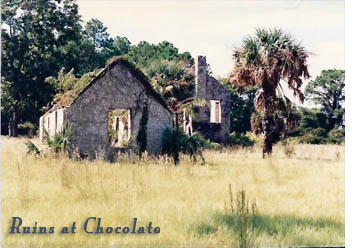With unfailing punctuality and a singular lack of fanfare the Sapelo Queen routinely departs civilization each morning at 8:30
bound for what I have come to call paradise.
The 30 minute boat ride through vistas of tidal marshland always seems to take me farther than the miles alone explain. Heading
straight into fresh seawinds the ferry is often accompanied by playful porpoises at the bow while a noisy band of seagulls trails
the stern. Everyone, it seems, knows the way. One day I will too!
The lure of Sapelo captured R. J. Reynolds 50 years ago. He was the last in a succession of millionaires to own
the island, and his interest in marine research was instrumental in creating the University of Georgia's Marine Institute in
1950. Reynolds invited faculty to set up shop in a converted dairy barn on his South End estate where for the first time
anywhere in the world research was concentrated on marshland ecology.
Surrounded by 16,000 acres of pristine marsh, Sapelo Island offers a rare opportunity for marine studies that are now acknowledged
world-wide, involving a resident research team, graduate students and visiting scientists from around the world.
Sapelo research has revealed that the protected nutrient-rich environment of the marsh, powered by the ebb and flow of the tide,
is crucial to the early stages of development in many species of fish and shellfish.
We now know that the health of the marsh is vital to Georgia's commercial and recreational fishing industry as well as to
the accompanying web of insects, birds, mammals and reptiles. The Sapelo studies have also enlightened us on the inner
workings of every other marsh ecosystem in the world.
Touring Sapelo with Cornelia Bailey, a lifelong resident, the past comes alive in no uncertain terms.
She will show you the largest shell midden found in North America, a mysterious 6-foot high ring of
oyster shells left by Native Americans centuries ago.
In another magical place the road turns to reveal a broad sunlit field and the tabby ruins of Le Chatelet,
the once resplendent estate of French nobility. In the restored dairy barn a wide-eyed screech owl peers
from 17th century rafters, almost invisible in the high shadows.
In nearby Bourbon Fields the newly plowed earth is sprinkled with hundreds of Indian pottery shards, each
with its own pattern of antiquity.
Most of Sapelo Island is now owned by the state of Georgia, but about 1% of the island still belongs to the
residents of Hog Hammock, a small community on the South End.
 Descendents of slaves who worked the island's plantations 200 years ago, these islanders now cling to a unique way of life that
has all but disappeared.
In my heart I can still see the way to Sapelo, feel again the gentle island sun trickle down through trees whispering in the wind.
I remember her sky-blue creeks curling through the marsh, deep live oak forests at the place called Hang Bull, the graceful arc
of Cabretta Beach where alligators sun themselves behind the dunes.
Descendents of slaves who worked the island's plantations 200 years ago, these islanders now cling to a unique way of life that
has all but disappeared.
In my heart I can still see the way to Sapelo, feel again the gentle island sun trickle down through trees whispering in the wind.
I remember her sky-blue creeks curling through the marsh, deep live oak forests at the place called Hang Bull, the graceful arc
of Cabretta Beach where alligators sun themselves behind the dunes.
I hear again the sudden rush of wings, see a hundred rice birds bursting from their hiding places in the marsh. Catching the wind
like a giant sail they are yanked skyward with a snap of the breeze, their shadows chasing down trees as they fly by.
Today there is no pull, no press of the clock on Sapelo.
In this quiet heartfelt place it seems even the ravagers of time have laid down their arms, and walked away in peace.
|

